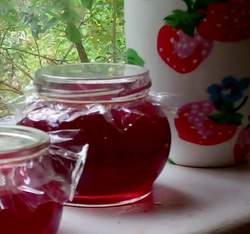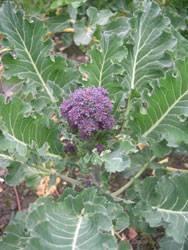Redcurrant jelly recipe to add a sparkle to your meals
Posted by Fiona Nevile in Jam Jelly and Preserves | 10 commentsWho needs to wear rubies when you can decorate your table with jewels such as these?
Redcurrant jelly is the king of jellies. All jellies shine but redcurrant jelly glitters. It enhances the food that it’s served with. If you’re only going to make one jelly in your life, make redcurrant. You’ll never regret it.
I’m pretty sure that my mother used make this when I was growing up. I remember that redcurrant jelly was the star turn of Sunday roast lamb. I’ve loved it since I can remember Mum hauling out the heavy roasting pan from the oven and kicking the door shut in one fell swoop. As she made the gravy on the stove top, I’d lay the table and find the redcurrant jelly in the larder.
It was never decanted, just set on a saucer with a teaspoon. I smothered that clear ruby brightness on lamb, potatoes and surreptitiously mixed it into the gravy – this even made the green vegetables taste better!
Red currant jelly is so easy to make and is in a completely different class than 99% of the jelly that is commercially available. This tends to be oversweet and must have something to do with the extra long shelf life that supermarkets insist on – more sugar preserves the jelly for their rule of a two year sell by date.
Don’t worry, all our jelly recipes last for ages. After a year or so they will start to thicken rather than go mouldy. This thick jelly is perfect for adding to casseroles and can be thinned by stirring in a little boiling water.
Red currant jelly is usually partnered with lamb but it’s good with any fatty meat such as pork too. It can also add a lot of zip to a Brie or goat’s cheese sandwich. I also like some spread lightly on warm buttered toast or Scotch pancakes if I need an energy boost mid afternoon.
If you don’t grow redcurrants see if you can find a pick your own nearby as currants are exorbitantly expensive in the shops. They are fiddly to pick, so this must be the reason why.
My recipe is sweet yet tart. Taste it when the sugar has dissolved before you start your rolling boil. Add a more sugar if you’d prefer it a little sweeter- adding the sugar in 50g increments, tasting after it has dissolved completely.
| Redcurrant jelly |
- • 800g of redcurrants, keep the stalks on and don’t top and tail.
- • water to cover the redcurrants (so they are just beginning to float)
- • White granulated sugar (the amount depends on the volume of juice extracted from the simmered, drained fruit. Ipt/570ml of juice to 1lb/400gms of sugar
- Wash the redcurrants and discard and bruised fruit. Put the redcurrants into a large saucepan and cover them with cold water.
- Bring the redcurrants and water to the boil and simmer very gently until all the fruit is soft and mushy (roughly 20 minutes, depending upon how ripe the fruit is).
- Pour the cooked fruit through sterilised muslin. (How do I sterilise muslin? See tips and tricks below). The muslin is often referred to as a “jelly bag”. We use tall buckets to catch the drips from the jelly bags. Rather than hang the bags (conventional method-between two stools) I find it easier to line a large plastic sieve with the muslin. This clips neatly onto the top of a clean bucket. The sieve is covered with a clean tea cloth to protect against flies, as the jelly bag generally drips overnight.
- Measure redcurrant juice the next day and pour it into a deep heavy bottomed saucepan. Add 400g/0.88 pounds of white granulated sugar for each 570ml/1 pt of juice.
- Heat the juice and sugar gently, stirring from time to time. Make sure that that all the sugar has dissolved before bringing the liquid slowly to the boil. Continue to boil for about five minutes before testing for a set. Our jelly took just ten minutes to set. (What is testing for a set? See tips and tricks below).
- Toss in a nugget of butter towards the end to reduce the frothing that often occurs.
- When jelly has reached setting point pour into warm sterilised jars using a funnel and ladle. (How do I sterilise jars? See tips and tricks below).
- Cover immediately with plastic lined screw top lids or cellophane tops secured with a rubber band. Label when cold and store in a cool, dark place. Away from damp. (What do I do if my jelly is too liquid? See Tricks and tips below)
- We had 1 pint of juice and this made 4 small jars of jelly.
Tips and tricks:
• What is a jelly bag?
A jelly bag is traditionally a piece of muslin but it can be cheesecloth, an old thin tea cloth or even a pillowcase. The piece needs to be about 18 inches square. When your fruit is cooked and ready to be put in the jelly bag, lay your cloth over a large bowl. Pour the fruit into the centre of the cloth and tie the four corners together so that they can be slung on a stick to drip over the bowl. Traditionally a stool is turned upside down, the stick is rested on the wood between the legs and the jelly bag hangs over the bowl. We experimented and now line a sieve with muslin, place it over a bucket and cover the lot with clean tea cloths (against the flies). An old piece of sheet, pillowcase or even a Jiffy cloth can be used instead of muslin.
• How do I sterilise muslin/the jelly bag?
Iron the clean jelly bag with a hot iron. This also works with tea cloths.
• What is Jam “set” or “setting point”?
Getting the right set can be tricky. I have tried using a jam thermometer but find it easier to use the following method. Before you start to make the jam, put a couple of plates in the fridge so that the warm jam can be drizzled onto a cold plate (when we make jam we often forget to return the plate to the fridge between tests, using two plates means that you have a spare cold plate). Return the plate to the fridge to cool for approx two minutes. It has set when you run your finger through it and leave a crinkly track mark. If after two minutes the cooled jam is too liquid, continue to boil the jam, testing it every few minutes until you have the right set. The jam is far more delicious if it is slightly runny.
• How do I sterilise jam jars?
We collect jars all year round for our jelly, chutney and jam making sessions. I try to soak off labels and store the clean jars and metal plastic coated screw-top lids in an accessible place. The sterilising method that we used is simple. Just before making the jam, I quickly wash and rinse the jars and place them upside down in a cold oven. Set the temperature to 160c (140c fan-assisted). When the oven has reached the right temperature I turn off the heat. The jars will stay warm for quite a while. I only use plastic lined lids for preserves as the all-metal lids can go rusty. I boil these for five minutes in water to sterilise them. If I use Le Parfait jars, I do the same with the rubber rings.
Leave a reply







I’ve just picked my red currants. Some are a bit underripe can I use those for my red currant jelly?
Yes
I found your recipe last year, it was a great success! We have only just finished our last jar of jelly…just in time for this years crop! I have literally just made this years jelly this morning!! We had twice as many currents than last year so plenty more to keep and give away too ????
I just made your redcurrant jelly, it’s turned out wonderful and crystal clear.
Thanks for such an easy recipe.
Apologies for going off subject slightly – 1st attempt at Cherry Jam with redcurrant juice for pectin content has come out far too soft and sweet with all the cherries at the top. The actual cherries are lovely but the rest is oversweet goo. Can I save this with more fruit and more boiling? (I think I got too much sugar by forgetting the weight of the cherry stones would’nt be in there…) I read once that you can save over set jelly with more juice, so I wondered if I could do the same. I’d welcome any advice!
Have you tried using your steam juicer for making jellies? It cuts out the draining overnight part of the process and produces perfectly clear jellies.
Pamela
For a change try adding some very finely chopped mint leaves to the jelly (or a jar full of it) when you have reached setting point. It works really well and this way you get to have both redcurrant and mint with your roast lamb. Yum
Can you please advise quantity of mint per 500 gms of redcurrants. Thanks
I have just picked mine but have At least half the quantity I had last year.
Still enough to make a few jars though so will try your recipe this year Fiona.
Love your little jars. I make it every year too, sometimes stirring in a tablespoon of port for each lb of redcurrants used, just before pouring into the jars.
We had a bumper crop of redcurrants here in France last year but this year, thanks to the weather, hardly any. And as for cherries….I had over 100lbs last year, this year Mr jjt363 found just 9 cherries to pick….no jam, crumble or pies for us sadly!